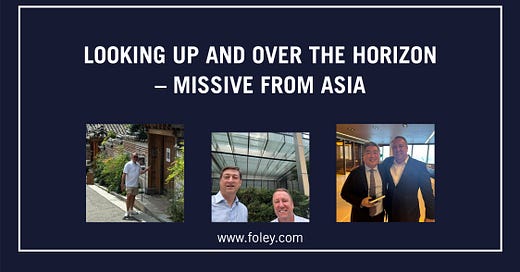Looking up and over the horizon — missive from Asia
This article was written by Louis Lehot on September 17, 2024.
Having just wrapped up a whirlwind tour of Seoul and Tokyo with my Foley & Lardner LLP colleagues Matthew Myungchul An, JillAllison Opell and Brian Wheeler, in this missive, I share some of my observations about what we saw in terms of business, technology and culture.
In only a week, we dove into the dynamic business landscape, particularly cross-border M&A and technology startup spaces. It was great to see old friends, and we made many new friends.
While we see many of the same trends as in Silicon Valley, we saw uniquely Korean observations in productivity automation, the future of work, gaming, AR/VR and AI. We also saw a big focus on climate-tech solutions, especially in Korea. In Tokyo, we saw a greater focus on cyber-security and fintech startups. In both places, we saw signs of a bustling technocratic middle class that is producing rapidly declining low birth rates — well below the rate of replacing the existing population — and without much immigration like we see in North America and Europe. While low birth-rates have been plaguing Japan for two decades, it has started to turn around. In Korea, the birth rate is reportedly now below Japan’s, and the decline has not stopped accelerating. This was surprising to us, and not well known in the U.S. And the consequences are not small… In Japan, foreign investment is rapidly piling in, as foreigners snap up real estate and assets at discounted prices. In Korea, fast growing industrial groups must look outside the country and to new technology to address a shrinking work force. We saw automated coffee shops and other services typically provided by humans on the eastern end of the Pacific while now delivered either digitally and robotically on the western end.
Korea’s innovation ecosystem is evolving rapidly, with 2023 seeing 5.4 trillion KRW in venture capital investments. Historically driven by government industrial policy and the chaebols, we visited and saw signs of an emerging class of venture capital fund managers focused on the startup space. The vibrant entrepreneurial spirit here sets the stage for more opportunities to come in tech and e-commerce, and especially climate-tech. Over to Tokyo, we had an insightful conversation with representatives of the JETRO Startup team on the evolving startup ecosystem in Japan. While total investment in Japanese startups currently represents only 3% of U.S. startup investment, the momentum is clearly building as the government gets organized and learns how to advance industrial policy with this powerful lever.
M&A has been impacted by very low exchange rates for the currencies in each of Korea (the won) and Japan (the yen), which makes outbound M&A more expensive for Asian conglomerates. This is partially offset by near zero interest rates to finance outbound growth and investment, which, with declining birth rates, has to be in growing markets elsewhere.
Culturally, we noticed that the after-effects of COVID were less apparent in Seoul. Most office workers come to work at least 4 days a week in Seoul (if not 5 or 6), and formal dress in suits and ties was widespread, even in the heat of late summer. In Tokyo, we noticed that office workers told us of working from the office only 2–3 days a week, with some telling us that they rarely come to the office, except for meetings. We also noticed that formal attire was much less prevalent, and casual-wear seemed to have become the norm.
Korean and Japanese automobile manufacturers continue to dominate their home markets, and we hardly saw a U.S. manufactured vehicle in either place (only a small handful of Teslas).
We noticed vast areas of construction in Seoul, with new office and apartment towers going up all over the place. The standard of living seemed to be on the upswing, with new restaurants, shops and stores sprouting at every turn. In Tokyo, we did not notice any new construction, and the standard of living appeared stable.
Last but not least, I couldn’t end without commenting on the food and drink. Koreans appear to favor a panoply of diverse cuisines, sporting a vast selection of Italian, French, Koreanized-Chinese food and Japanese food (both hot and cold) restaurants. Of course, we had to have (at least one) Korean barbeque with soju-bombs (shot of Korean rice wine poured in Korean beer), but noticed that basic and rare French, Italian and California wines were available at only a small markup to U.S. prices. In Japan, we enjoyed very small restaurants and bars where there was a focus on local Japanese cuisine, fresh ingredients, all masterfully prepared. The Japanese were very proud of their sake, their beer and their whiskey, which was ubiquitous in our travels through Tokyo.
Thanks to the many old friends we had a chance to visit, and all of the new friends we made, for making our trip to so memorable.




